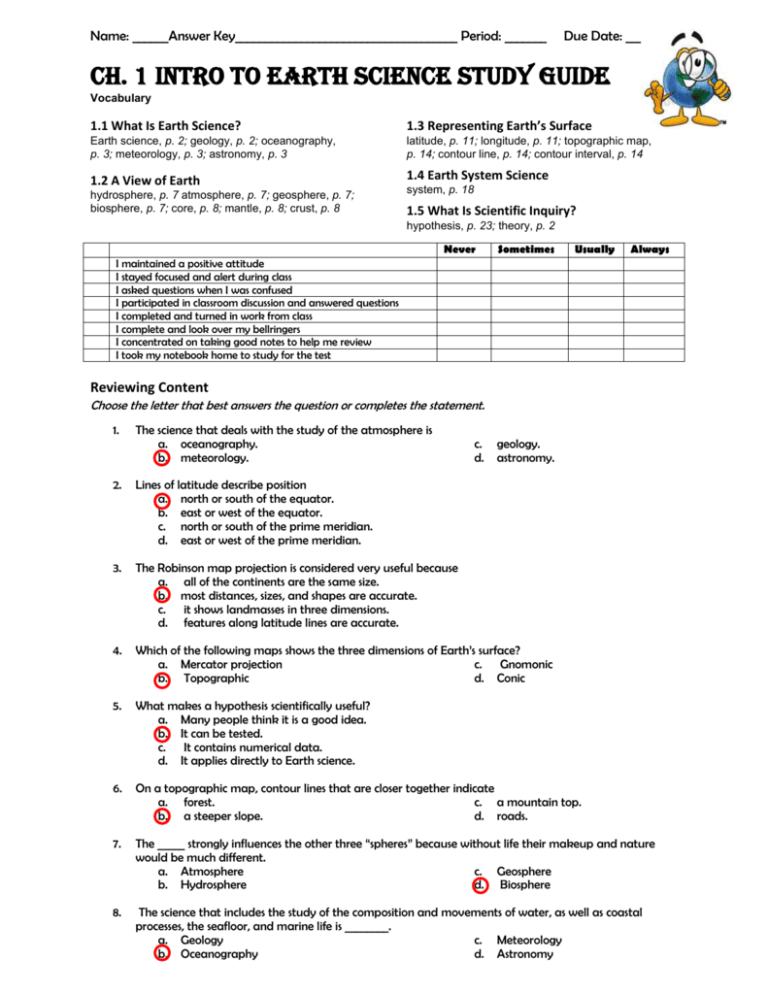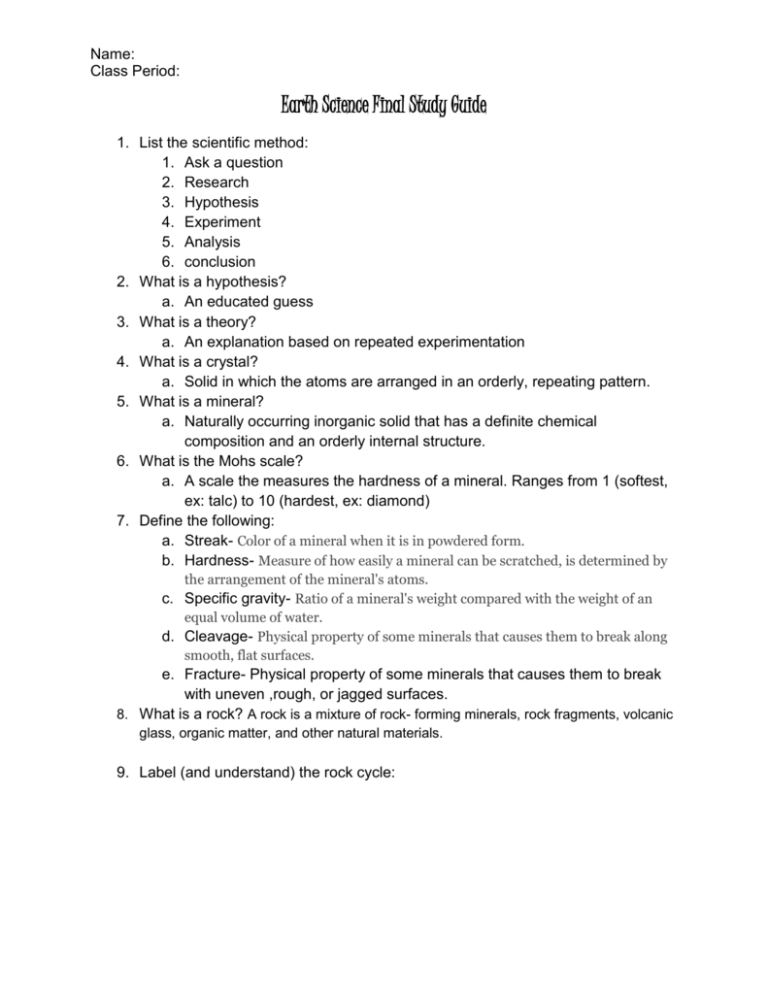Imagine standing on a mountain peak, gazing at the sprawling landscape below. You see towering cliffs, winding rivers, and lush forests, each telling a story of Earth’s relentless transformation. But what forces shaped these features? What secrets lie beneath the surface of our planet? This is the realm of Earth science, a captivating field that unveils the mysteries of our planet and its dynamic processes.

Image: studylib.net
If you’re eager to delve into this fascinating world, you’ve come to the right place. This comprehensive study guide will equip you with the knowledge and understanding to explore the intricate workings of our planet. We’ll delve into the core concepts, unravel the history of Earth, and uncover the significance of this field in our everyday lives.
Understanding Earth’s Dynamic Nature: A Journey into Our Planet’s Core
Earth science is the study of the Earth, its history, its composition, and the processes that shape it. It’s a multidisciplinary field that encompasses geology, meteorology, oceanography, and more. By studying Earth science, we unravel the secrets of plate tectonics, understand the forces driving climate change, and gain insights into natural disasters like earthquakes and volcanic eruptions.
From Mountain Ranges to Ocean Depths: A Look at the Earth’s Structure
Let’s start with the basics. The Earth, like an onion, is structured in layers, each with unique properties:
- The Crust: This is the outermost, rocky layer, forming the continents and ocean floor. It’s thin but incredibly diverse, ranging from towering mountain peaks to deep ocean trenches.
- The Mantle: This thick layer, composed of dense rock, lies beneath the crust. It’s constantly moving, creating the forces behind plate tectonics.
- The Outer Core: This liquid layer is composed primarily of iron and nickel, generating Earth’s magnetic field, which protects us from harmful solar radiation.
- The Inner Core: Located at the Earth’s center, this solid ball of iron and nickel exists under immense pressure.
Unveiling the Past: Earth’s History and Geological Time
Earth science is not just about the present; it’s a journey through time. By studying rocks, fossils, and geological formations, we can reconstruct the Earth’s history.
- Geological Time Scale: This timeline divides Earth’s history into eons, eras, periods, and epochs, marking significant events like mass extinctions and the emergence of different life forms.
- Fossils: These remnants of ancient life provide invaluable insights into how life evolved on Earth. Examining fossils allows us to understand past climates, ecosystems, and the evolution of species.
- Rock Formations: Different types of rocks, like igneous, sedimentary, and metamorphic, tell stories of their formation processes and the environments they originated from. Studying these rocks allows us to reconstruct past geological events and environments.

Image: studylib.net
The Driving Force: Plate Tectonics and Shaping the Planet
One of the most fundamental concepts in Earth science is plate tectonics. This theory explains how the Earth’s outer layer, the lithosphere, is made up of large, rigid plates that are constantly moving.
- Plate Boundaries: The interactions between these plates at their boundaries result in various geological phenomena like earthquakes, volcanoes, and mountain building.
- Continental Drift: The theory of continental drift, a precursor to plate tectonics, proposed that the continents were once joined together in a supercontinent called Pangaea.
Earth’s Atmosphere: The Air We Breathe and Its Impact
The Earth’s atmosphere is a vital component of our planet, providing us with breathable air and protecting us from harmful solar radiation.
- Atmospheric Layers: The atmosphere is divided into layers, each with unique properties, from the troposphere, where weather occurs, to the thermosphere, which absorbs solar radiation.
- Climate Change: Human activities have significantly altered the composition of the atmosphere, leading to global warming and climate change, impacting weather patterns, sea levels, and ecosystems around the world.
Exploring the Oceans: The Blue Heart of our Planet
Oceans cover more than 70% of the Earth’s surface, playing a crucial role in regulating climate, supporting diverse marine life, and providing resources for humanity.
- Ocean Currents: These moving masses of water distribute heat around the globe, influencing weather patterns and climate.
- Marine Ecosystems: From coral reefs to deep-sea hydrothermal vents, oceans harbor a remarkable array of life, contributing to the delicate balance of Earth’s ecosystems.
Earthquakes and Volcanoes: The Dynamic Forces Shaping Landscapes
Earthquakes and volcanic eruptions are dramatic manifestations of the Earth’s internal processes.
- Earthquakes: These sudden releases of energy occur along fault lines, where tectonic plates move past each other.
- Volcanoes: Volcanoes erupt when molten rock, called magma, rises to the surface, creating spectacular displays of nature’s power.
Resources, Hazards, and the human Impact: Earth Science in Our Lives
Earth science is more than just theoretical knowledge; it has direct implications for our lives. We rely on Earth’s resources for energy, food, and materials, while also facing risks from natural disasters.
- Natural Resource Management: Understanding Earth’s resources, like fossil fuels, minerals, and water, is essential for sustainable development and responsible resource management.
- Disaster Mitigation: Earth science research helps us predict and prepare for natural disasters like earthquakes, tsunamis, and volcanic eruptions, minimizing the risks and protecting lives.
Actionable Tips for Success in Earth Science
- Engage with the Field: Explore museums, documentaries, and documentaries to visualize the concepts you’re learning.
- Ask Questions: Be curious, and don’t hesitate to ask questions in class or seek additional information online.
- Apply Your Knowledge: Connect Earth science concepts to real-world examples you encounter in your daily life.
Earth Science Study Guide
Conclusion: Embracing the Wonders of Our Planet
Earth science is a journey of exploration, discovery, and understanding. From the fiery depths of volcanoes to the delicate balance of ecosystems, our planet constantly reveals beauty and complexity. By studying Earth science, we not only unravel the mysteries of our world but also gain valuable insights into our role as responsible stewards of our planet. So, continue your journey of learning, embracing the wonders of Earth, and contributing to a more sustainable future.





